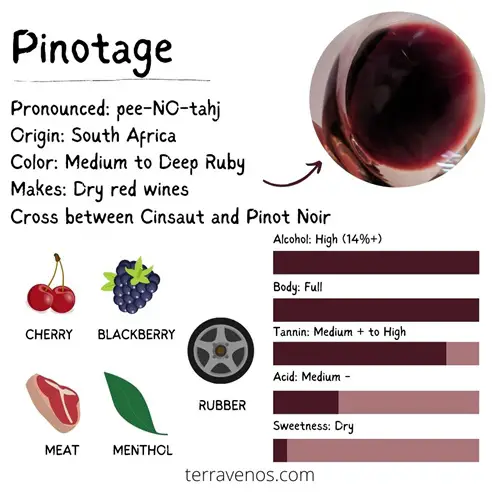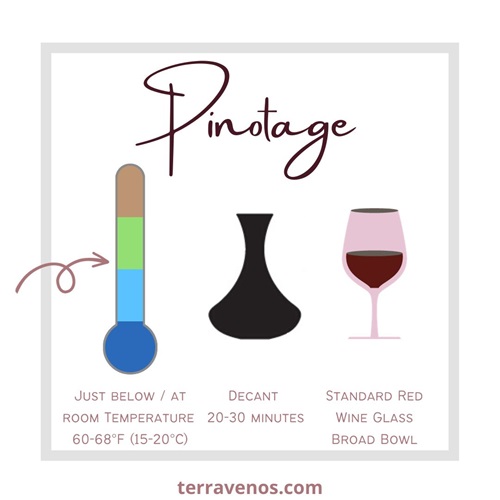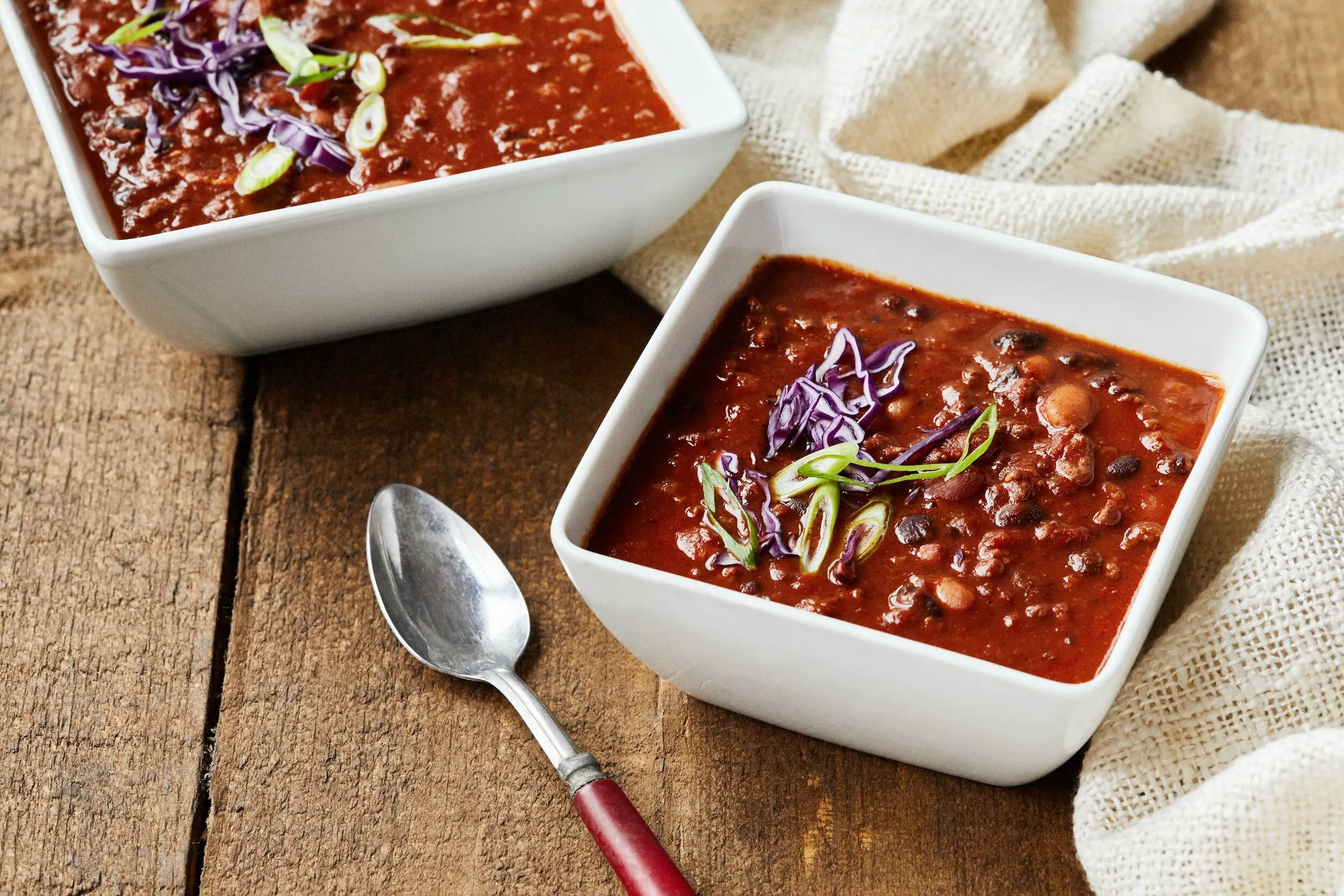Pronunciation: pee-NO-tahj

Pinotage is a red wine grape originally hailing from South Africa. Pinotage makes a robust, medium to full-bodied dry red wine with a unique fusion of dark berries, earth, and spice notes.
- What Kind of Wine is Pinotage?
- Where Does Pinotage Wine Come From?
- Other Notable Pinotage Growing Regions
- Is Pinotage the Same as Pinot Noir?
- What Is Pinotage Similar To?
- What Does Pinotage Smell Like?
- What Does Pinotage Taste Like?
- How to Serve Pinotage Wine
- Pinotage Food Pairing Suggestions
- Pinotage vs. Other Varietals
- Notable Pinotage Producers and Bottles to Try
- Sustainable Practices in Pinotage Vineyards
- Emerging Trends and Innovations
- Final Thoughts – Pinotage as Must-Try Red Wine Varietal
- Thirsty for More?
What Kind of Wine is Pinotage?
Pinotage is a red wine with a robust character, moderate acidity, medium to pronounced tannins, and higher alcohol. Its style often falls between Malbec and Syrah or Carmenere.
Where Does Pinotage Wine Come From?
Pinotage, a red wine grape originating in South Africa, was created by crossing Pinot Noir and Cinsaut grapes. Dr. Abraham Perold, a prominent viticulturist at Stellenbosch University, was trying to develop more disease-resistant wine grapes. His goal was to combine the elegance of Pinot Noir with the resilience of Cinsaut.
This new grape, aptly named Pinotage, found a natural home in the diverse terroir of South Africa’s Western Cape.
Pinotage in South Africa
South Africa, with its varied landscapes, provides an ideal setting for Pinotage cultivation. It thrives in regions like Stellenbosch and Swartland, contributing to the production of distinctive red wines that showcase the essence of South African winemaking.
Other Notable Pinotage Growing Regions
Beyond South Africa, Pinotage has limited production in New Zealand and the United States. It’s a finicky grape to work with.
Is Pinotage the Same as Pinot Noir?
Pinotage is not the same as Pinot Noir, despite their similar sounding names. However, one of Pinotage’s parent grapes is Pinot Noir. Pinotage can often have a red berry and earthy quality to it thanks to its Pinot Noir parent.
What Is Pinotage Similar To?
Pinotage is similar to big red wines like Cabernet Sauvignon, Carmenere, and Syrah. It’s a full-bodied, tannic red wine with a meaty, earthy edge to it.
What Does Pinotage Smell Like?
Pinotage carries a distinctive aroma, with prominent notes of dark berries, earthiness, and a touch of smokiness, maybe even leather, tobacco, and meat. Well-made Pinotage wines will have a layered complexity of fruit, mineral, and floral notes. Take time to swirl these wines. Poorly made Pinotage smells like paint, rubber, and roadkill. Please don’t drink poorly made Pinotage.
Fun Wine Fact: Pinotage is a picky grape to grow and make wine. It can often smell like rubber if it’s not made well.
What Does Pinotage Taste Like?
Pinotage showcases a broad flavor spectrum, influenced by both parent grapes. In cooler climates, it presents vibrant red fruit flavors, while warmer regions yield wines with richer, fuller-bodied profiles.
On the palate, Pinotage features moderate to lower acidity, giving the wine a plushness on the palate. The tannins tend to be higher, though not rasping.
Helpful Tip: Check out this 30-second tasting tip on how to taste wine tannins.
Is Pinotage a Heavy Wine?
Pinotage is typically a heavy wine, with a full body and higher alcohol (14%+ AVB). Pinotage made from grapes grown in cooler climates will be medium bodied.
How to Serve Pinotage Wine

Temperature
Serve Pinotage slightly below room temperature, around 60-68°F (15-20°C), to allow the complex aromas to unfold without being overwhelmed by higher alcohols.
Glassware
Choose a standard red wine glass with a slightly curved rim and a broad bowl to enhance aeration. This design concentrates the aromas, making it easier to appreciate the nuanced characteristics of Pinotage. If you have a Bordeaux wine glass, then that’s what you’ll want to use.
Decanting
Fuller-bodied Pinotage benefits from 20-30 minutes of aeration. If you find your Pinotage closed and not very aromatic after pouring yourself a glass, let it sit for 10 minutes and revisit. Give it a good swirl. This will help, too.
Aging Potential
Pinotage evolves with age, gaining complexity and savory notes. Think leather and black tea. Quality Pinotage that’s fuller-bodied and tannic can age for 5-10 years or even longer. Let pricepoint be your guide.
Pinotage Food Pairing Suggestions

Pinotage is a big wine that works with big dishes. Embrace the earthy undertones and grippy tannins by pairing it with grilled meats, hearty stews, or flavorful cheeses.
Quick Tips: Pinotage Food Pairing
- Chili (Pinotage is my go-to chili wine)
- BBQ
- Tacos
- Nachos
- Burgers and fries
- Aged cheddar or gouda cheese
Pinotage vs. Other Varietals
Pinotage isn’t quite as herbaceous as Cabernet Sauvignon and has a meaty quality that the Cabernet family often lacks. It’s much closer to its parent grape, Cinsaut than its Pinot Noir parent, with a tannic backbone that will catch your attention.
Pinotage will be unlike any other mainstream red you’ve tasted!
Notable Pinotage Producers and Bottles to Try

When exploring Pinotage, seek out wineries known for their expertise in working with this grape. Keep an eye on producers like:
- Kanonkop (Stellenbosch, South Africa) – Personal Favorite
- Beyerskloof (Stellenbosch, South Africa)
- L’Avenir (Stellenbosch, South Africa)
These wineries offer a range of Pinotage wines, each showcasing the grape’s unique characteristics.
Fun Wine Fact: Each year the South Africa Pinotage Association hosts a Pinotage competition, nominating the 10 best Pinotage wines that serve as benchmarks for this little grape. ANY of these wines will be amazing!
Sustainable Practices in Pinotage Vineyards
Pinotage’s woes start in the vineyard. Pinotage vines can produce copious quantities of fruit that can make lower-quality, less intensive wines. Winemakers can get away with this because Pinotage grapes make deeply colored wines and the consumer (wine drinker) believes that color and quality are connected. Winegrowers can use fruit from heavy-yielding Pinotage vineyards and still make dark red wines (more volume, lower quality). Sadness. This still happens.
Additionally, South African viticulture faces several challenges, including drought. Pinotage needs special care in the vineyard to make sure that it ripens fully and isn’t water-stressed. Water stress can lead to rubbery, paint-like notes in the final wine. Higher quality Pinotage reflects better vineyard practices. If you have a rubbery Pinotage, chances are that there were issues in the vineyard during that vintage.
Fun Wine Fact: Pinotage has a relatively short history compared to some other grape varieties, first developed in the 1920s.
Emerging Trends and Innovations
Because Pinotage is a relatively new grape, winemakers are still learning how to work with it in the winery. Careful temperature control during fermentation can reduce unpleasant rubbery notes in the final wine. Well-crafted Pinotage is a wonderous discovery for wine enthusiasts.
Final Thoughts – Pinotage as Must-Try Red Wine Varietal
With its distinctive flavor profile, versatile pairing options, and aging potential, Pinotage stands as a red wine varietal worth exploring. Here are three key takeaways:
- Distinctive Flavor Profile: Pinotage offers a medley of dark berries, earthiness, and subtle smokiness. Its moderate acidity contributes to a refreshing experience, while the tannins provide a solid backbone.
- Food-Friendly: Pinotage pairs well with heavier dishes, including hearty meats, stews, and aged cheeses, making it a great cold-weather red wine.
- Pricepoint Matters: Pinotage is probably the single most important wine where you want to buy higher-priced bottles. If you have the choice between a $15 USD Pinotage and a $25 USD Pinotage, get the $25 bottle.
Thirsty for More?
Love robust red wines? Discover more bold red wine recommendations to broaden your palate.
Curious about food and wine pairings? Check out this quick guide to get started with food and wine pairing.




